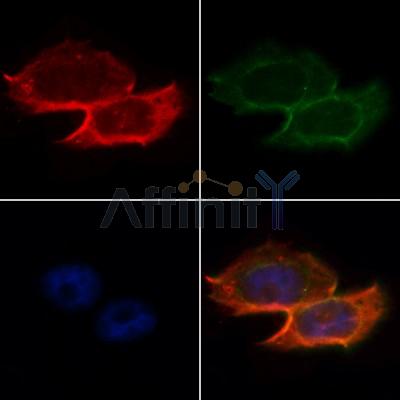MAP2 Antibody - #AF5156
Related Downloads
Protocols
Product Info
*The optimal dilutions should be determined by the end user. For optimal experimental results, antibody reuse is not recommended.
*Tips:
WB: For western blot detection of denatured protein samples. IHC: For immunohistochemical detection of paraffin sections (IHC-p) or frozen sections (IHC-f) of tissue samples. IF/ICC: For immunofluorescence detection of cell samples. ELISA(peptide): For ELISA detection of antigenic peptide.
Cite Format: Affinity Biosciences Cat# AF5156, RRID:AB_2827689.
Fold/Unfold
DKFZp686I2148; MAP 2; MAP dendrite specific; MAP-2; MAP2; MAP2A; MAP2B; MAP2C; Microtubule associated protein 2; Microtubule-associated protein 2; MTAP2_HUMAN;
Immunogens
A synthesized peptide derived from human MAP2, corresponding to a region within N-terminal amino acids.
- P11137 MTAP2_HUMAN:
- Protein BLAST With
- NCBI/
- ExPASy/
- Uniprot
MADERKDEAKAPHWTSAPLTEASAHSHPPEIKDQGGAGEGLVRSANGFPYREDEEGAFGEHGSQGTYSNTKENGINGELTSADRETAEEVSARIVQVVTAEAVAVLKGEQEKEAQHKDQTAALPLAAEETANLPPSPPPSPASEQTVTVEEDLLTASKMEFHDQQELTPSTAEPSDQKEKESEKQSKPGEDLKHAALVSQPETTKTYPDKKDMQGTEEEKAPLALFGHTLVASLEDMKQKTEPSLVVPGIDLPKEPPTPKEQKDWFIEMPTEAKKDEWGLVAPISPGPLTPMREKDVFDDIPKWEGKQFDSPMPSPFQGGSFTLPLDVMKNEIVTETSPFAPAFLQPDDKKSLQQTSGPATAKDSFKIEEPHEAKPDKMAEAPPSEAMTLPKDAHIPVVEEHVMGKVLEEEKEAINQETVQQRDTFTPSGQEPILTEKETELKLEEKTTISDKEAVPKESKPPKPADEEIGIIQTSTEHTFSEQKDQEPTTDMLKQDSFPVSLEQAVTDSAMTSKTLEKAMTEPSALIEKSSIQELFEMRVDDKDKIEGVGAATSAELDMPFYEDKSGMSKYFETSALKEEATKSIEPGSDYYELSDTRESVHESIDTMSPMHKNGDKEFQTGKESQPSPPAQEAGYSTLAQSYPSDLPEEPSSPQERMFTIDPKVYGEKRDLHSKNKDDLTLSRSLGLGGRSAIEQRSMSINLPMSCLDSIALGFNFGRGHDLSPLASDILTNTSGSMDEGDDYLPATTPALEKAPCFPVESKEEEQIEKVKATGEESTQAEISCESPFLAKDFYKNGTVMAPDLPEMLDLAGTRSRLASVSADAEVARRKSVPSETVVEDSRTGLPPVTDENHVIVKTDSQLEDLGYCVFNKYTVPLPSPVQDSENLSGESGTFYEGTDDKVRRDLATDLSLIEVKLAAAGRVKDEFSVDKEASAHISGDKSGLSKEFDQEKKANDRLDTVLEKSEEHADSKEHAKKTEEAGDEIETFGLGVTYEQALAKDLSIPTDASSEKAEKGLSSVPEIAEVEPSKKVEQGLDFAVQGQLDVKISDFGQMASGLNIDDRRATELKLEATQDMTPSSKAPQEADAFMGVESGHMKEGTKVSETEVKEKVAKPDLVHQEAVDKEESYESSGEHESLTMESLKADEGKKETSPESSLIQDEIAVKLSVEIPCPPAVSEADLATDERADVQMEFIQGPKEESKETPDISITPSDVAEPLHETIVSEPAEIQSEEEEIEAQGEYDKLLFRSDTLQITDLGVSGAREEFVETCPSEHKGVIESVVTIEDDFITVVQTTTDEGESGSHSVRFAALEQPEVERRPSPHDEEEFEVEEAAEAQAEPKDGSPEAPASPEREEVALSEYKTETYDDYKDETTIDDSIMDADSLWVDTQDDDRSIMTEQLETIPKEEKAEKEARRSSLEKHRKEKPFKTGRGRISTPERKVAKKEPSTVSRDEVRRKKAVYKKAELAKKTEVQAHSPSRKFILKPAIKYTRPTHLSCVKRKTTAAGGESALAPSVFKQAKDKVSDGVTKSPEKRSSLPRPSSILPPRRGVSGDRDENSFSLNSSISSSARRTTRSEPIRRAGKSGTSTPTTPGSTAITPGTPPSYSSRTPGTPGTPSYPRTPHTPGTPKSAILVPSEKKVAIIRTPPKSPATPKQLRLINQPLPDLKNVKSKIGSTDNIKYQPKGGQVQIVTKKIDLSHVTSKCGSLKNIRHRPGGGRVKIESVKLDFKEKAQAKVGSLDNAHHVPGGGNVKIDSQKLNFREHAKARVDHGAEIITQSPGRSSVASPRRLSNVSSSGSINLLESPQLATLAEDVTAALAKQGL
Predictions
Score>80(red) has high confidence and is suggested to be used for WB detection. *The prediction model is mainly based on the alignment of immunogen sequences, the results are for reference only, not as the basis of quality assurance.
High(score>80) Medium(80>score>50) Low(score<50) No confidence
Research Backgrounds
The exact function of MAP2 is unknown but MAPs may stabilize the microtubules against depolymerization. They also seem to have a stiffening effect on microtubules.
Phosphorylated at serine residues in K-X-G-S motifs by MAP/microtubule affinity-regulating kinase (MARK1 or MARK2), causing detachment from microtubules, and their disassembly (By similarity). Isoform 2 is probably phosphorylated by PKA at Ser-323, Ser-354 and Ser-386 and by FYN at Tyr-67. The interaction with KNDC1 enhances MAP2 threonine phosphorylation (By similarity).
Cytoplasm>Cytoskeleton. Cell projection>Dendrite.
References
Application: IF/ICC Species: rat Sample: colon tissues
Restrictive clause
Affinity Biosciences tests all products strictly. Citations are provided as a resource for additional applications that have not been validated by Affinity Biosciences. Please choose the appropriate format for each application and consult Materials and Methods sections for additional details about the use of any product in these publications.
For Research Use Only.
Not for use in diagnostic or therapeutic procedures. Not for resale. Not for distribution without written consent. Affinity Biosciences will not be held responsible for patent infringement or other violations that may occur with the use of our products. Affinity Biosciences, Affinity Biosciences Logo and all other trademarks are the property of Affinity Biosciences LTD.






